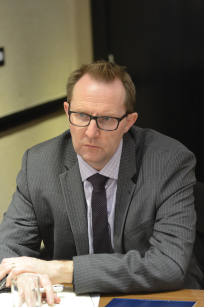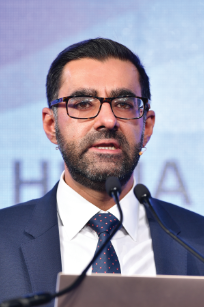Feature / Our business
It can be easy to see health inequalities as someone else’s business, an issue for clinicians or public health specialists to address. But increasingly, the financial role in improving equity is being recognised.
‘It is absolutely the business of the finance profession,’ says Lee Outhwaite, finance director of Chesterfield Royal Hospital NHS Foundation Trust and of Derbyshire Community Health Services NHS Foundation Trust. ‘It has got everything to do with how well we allocate resources – are we having the maximum impact we can with our spending and are we doing the right things?’
He is equally adamant that this is not simply a commissioning issue, but one that provider organisations have to be just as focused on. ‘How do we ensure we’ve got good, equitable, fair access to our services?’ he asks.
Mr Outhwaite (pictured) says you don’t have to look far to find evidence that things are not right currently. ‘In the most deprived part of Derby city, a 49-year-old male can expect to have 1,000 more days of healthy life,’ he says. ‘Someone the same age living in the most affluent part of Derby can expect to live another 20 years of healthy life.’ And the gap is even wider for women.
Every area would recognise statistics such as these, with often stark differences in life chances of people living short distances apart.
It is not just that people are noticing existing health inequalities, but that it’s getting worse. In 2020, Michael Marmot published a follow-up to his landmark review of public health in England. He concluded that improvements in life expectancy, experienced from the beginning of the 20th century, had since 2011 ‘slowed dramatically, almost grinding to a halt’.
For part of the decade, life expectancy actually fell in the most deprived communities outside London for women and in some regions for men. And Professor Marmot noted that for men and women everywhere, the time spent in poor health was increasing.
Covid-19 has also thrown a spotlight on health inequalities, having a disproportionate impact on those living in areas of high deprivation, as well as on black, Asian and minority ethnic communities. Vaccination uptake, which feeds into Covid outcomes, was also slower and less comprehensive among different population groups.
‘At the community trust, in almost everything we deliver, we observe differentially high access from the haves and lower access from the have-nots,’ says Mr Outhwaite.
He argues that the service as a whole could get better outcomes if it reached out to more deprived and under-serviced communities.
‘We are not trying to achieve equality, where everybody gets the same treatment and support,’ he adds. ‘We are looking for equity, which may mean allocating more to those who need it, proportionate to their circumstances.’
He admits it is ‘exceptionally hard’. If the NHS is serious about narrowing the gap, it will need to start having conversations about areas that it can disinvest in – or not apply growth to – to enable increased investment in other areas.
Addressing the wider determinants of health is likely to deliver the biggest gains in levelling up health outcomes, he says. But the headroom to do this will only be created by improving integration between secondary and primary care services and between health and care services. More outreach by secondary care clinicians into primary care could eliminate waste and help avoid unnecessary admissions. And better social care could enable hospitals to move fit patients out of hospital quicker.
Waiting list analysis
One trust has highlighted the very real inequalities in access to care and shown that something can be done about. In March last year, Calderdale and Huddersfield NHS Foundation Trust analysed its waiting list, focusing on patients waiting for operations.
It found that patients from ethnic minority groups were waiting on average 15.2 weeks for a priority 2 operation – operations that should be performed within a month. This was 7.2 weeks longer than white patients.
By December the average for all patients was 4.4 weeks, with black, Asian and minority ethnic (BAME) patients actually waiting 0.2 weeks less than white patients.
Similarly, using a deprivation lens, patients from the most deprived areas in May were waiting on average 8.5 weeks longer for treatment than those from the most affluent areas. This improved by the end of the year, with the gap reducing to two weeks.
The study was instigated by the trust’s then chief executive, Owen Williams, who also chairs NHS England’s Health Inequalities Expert Advisory Group. Gary Boothby (pictured), the trust’s finance director, says: ‘The data is really powerful. When we saw it at the board, we were really surprised.’
Overlaying data about deprivation (using IMD – the index of multiple deprivation) and ethnicity was new for the trust. ‘I don’t believe we have anybody in our booking teams who decides to make somebody from a certain postcode or with a particular surname wait longer,’ says Mr Boothby. ‘I’m confident that is not happening. But it was quite clear patients from a BAME background or patients from areas with a lower IMD were waiting longer.’
The trust spent a lot of time trying to understand what was driving this. ‘There are language barriers and a difference in the ability to manage the system,’ Mr Boothby says. ‘We’ve realised some IT systems aren’t always that easy to navigate in terms of booking slots or accepting dates.’ Communication difficulties can also lead to delays in pre-operative tests.
The trust recognised that people in lower paid employment may not have as much flexibility in getting time off for hospital appointments. It also acknowledged that there was less trust in health services among some communities, so the organisation had to think more about engaging with different people in different ways.
In response to the data analysis of its whole waiting list, the trust made several changes. First, it committed to prioritising patients with learning disabilities, having identified these people made up a disproportionately high number of its over 52-week waiters.
There were explanations for this – patients with learning disabilities may need more time on a list or require additional clinicians – but the trust recognised that this did not justify the longer waits.
More generally, in terms of deprivation and ethnicity, the trust has changed some of its communications – making letters easier to understand, for example – and the way it engages. But Mr Boothby says simply the process of making the organisation and staff aware of the problem has been the main contributor to improvement. Staff are more likely to enquire about what support might be needed to make an appointment, for example.
‘If other organisations did the same analysis, they might be in the same position,’ he says. ‘The key to the improvement has been the data and the knowledge of problem. We haven’t cracked it. We are still asking the questions and have a continuing workstream.’ He urges all trusts to undertake the same type of analysis.
Usman Niazi (pictured), chief financial officer of South East London Clinical Commissioning Group, says addressing health inequalities is even more complex than looking at outcomes or access by different groupings. ‘What surprised me in south-east London was the big disparity between and within ethnic groups,’ he says. Outcome and access inequalities are much more stark for people from a black African or black Caribbean background than for other groups, for example.
Engagement issues
Poorer outcomes also have a financial impact, with evidence showing clearly that health inequalities in deprived communities lead to higher costs, particularly in acute settings. ‘One reason is that these population groups often don’t feel like they can use primary care and early intervention services, so they only present in crisis,’ says Mr Niazi.
He says the quality of life experienced by these communities is not acceptable and there are opportunities to re-channel funding earlier in the pathway in ways that will improve outcomes. The Covid-19 vaccination programme has shown that trust is a key issue in vaccine uptake, with a better understanding of how to engage with different communities through community centres and religious facilities helping to improve jab rates.
‘The thing that it really drew out was the power of hyper-local information and action at an almost street-by-street level,’ Mr Niazi adds.
He says systems have the opportunity to use similar local data – analysing outcomes by lower layer super output areas (LSOAs) – to help meet needs in a more targeted way.
‘The information we have allows us to accurately predict the number of people in an area with undiagnosed hypertension or diabetes [comparing known cases with expected cases], giving us the opportunity to outreach to them to help get them into some early action preventative programme.’
Mr Niazi stresses that the key is to provide ‘actionable insight’ rather than simply churning out volumes of data. ‘I want to see one page that tells me the five things in these areas that teams should do now,’ he says. The CCG has commissioned work to test this hypothesis, and quantify the costs of health inequalities in the south-east corner of the capital.
‘As well as data, we also need to find more effective ways of serving deprived groups,’ Mr Niazi says. ‘For example, that means focusing on building strong, trusting relationships with people from deprived communities and delivering the sort of care people from these communities want to receive.’ That might mean peer support in a mental health crisis rather than more traditional NHS services.
Identifying the cost of health inequalities nationally may help to make the case for action generally, but Mr Niazi wants something more specific. ‘What do health inequalities mean in terms of how many times people come into hospital more than others, for what conditions, at what point in the journey and how do you stop it happening?’ he says.
Making the financial case for addressing health inequalities will be crucial. ‘We have to have evidence and an empirical base on which to make decisions,’ he says. ‘We need to quantify the cost of inequality, and the sets of interventions need to be backed up by a business case that shows the return on investment and timeframe.
‘I don’t buy that it will take two decades to deliver a payback. Everyone we stop from having a mental health crisis today, for example, potentially stops someone turning up in the emergency department.’
Mr Niazi says the system must collectively own the health inequalities agenda. It will need to get back to delivering efficiencies, confine waiting list spending to the elective recovery funds received and concentrate growth on investment in its shared priorities, with health inequalities at the top of the agenda.
‘The ethical arguments for addressing health inequalities should be what drive us, but the financial case for doing so is also compelling and important to ensuring the sustainability of the programmes we need to put in place to reduce health inequalities,’ he says.
Related content
We are excited to bring you a fun packed Eastern Branch Conference in 2025 over three days.
This event is for those that will benefit from an overview of costing in the NHS or those new to costing and will cover why we cost and the processes.